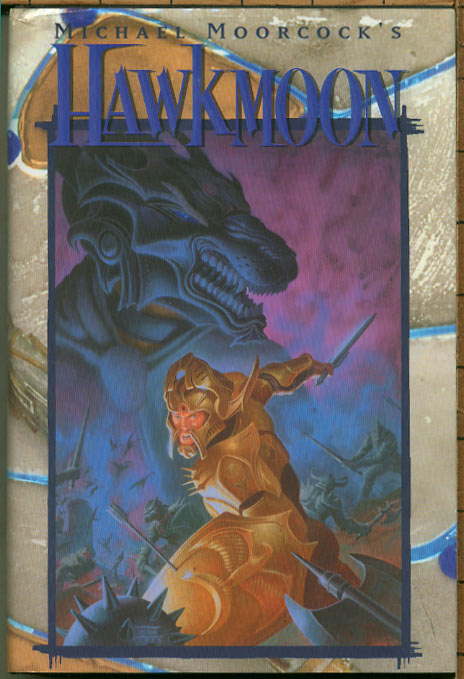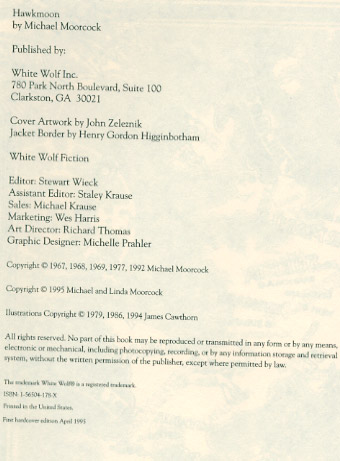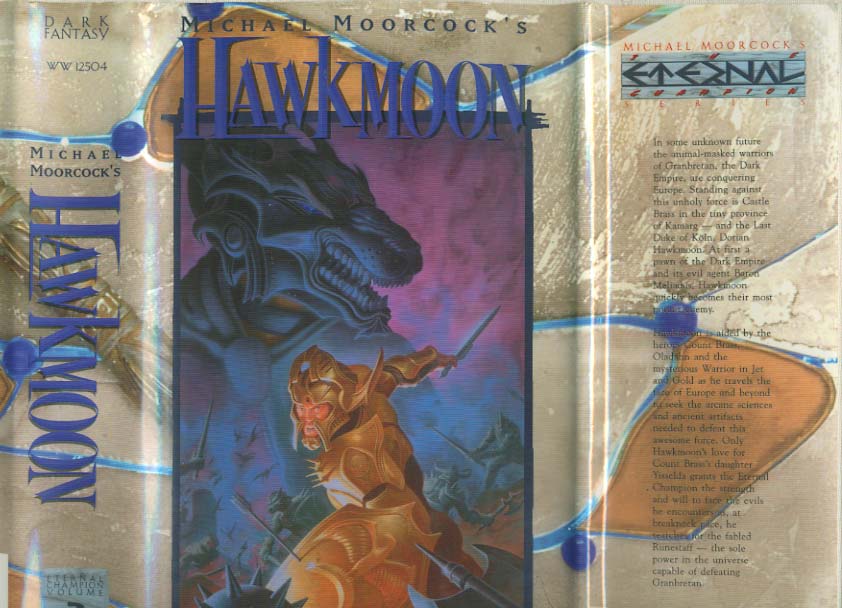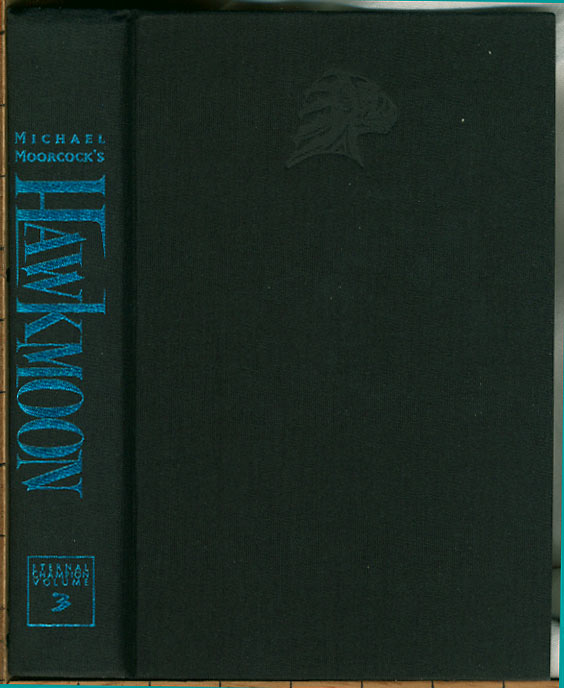
picture 2 of 4 Top

author:
title:
Moorcock, Michael
HAWKMOON
(reprint) omnibus: 1979
edn-date:
printing:
format:
cvr art:
cvr price:
GRADING:
1995
1st-AM
(Tall) Hardcover
John Zeleznik
$19.99
Book= Fine-
Dustjacket= Fine-
White Wolf: "first hardcover edition April 1995" (the British version with the same title explained in the summary was 1992.) Cover by John Zelezniki & interior illustrations by James Cawthorn, 502 pages, price (at bottom of back cover) is $19.99. Size is 6-1/4" by 9-1/4" by 1-5/8" thick. Condition is Fine (-) in a Fine (-) dustjacket: tight and square; corners are not bumped; top spine end is lightly bumped; age tanning is mild and uniform. Unclipped DJ has no tears; the only wear is/are some faint rubbing traces, and trace of wear at top of spine. No stamps, marks or writing - a very clean copy that looks new/unread.
The omnibus Hawkmoon is 3rd in both the Millenium (British) and White Wolf (American) "Tales of the Eternal Champion" compilations, and while the first 3 in each compilation have the same titles - this is the first pair to have matching contents. Both are re-titles/re-collections of the same set of 4 books first collected as The History of the Runestaff in 1979 (in Britain.) These original 4 Hawkmoon books are my favorites by Moorcock - I strongly recommend them.
From a comment in his introduction, I infer the reprinted James Cawthorn interior artwork may come from graphic-novel versions of the works (copyright dates of 1979, 1986, and 1994 are given.) Since the copyrights on the credits-page include 1977 in addition to the original range of 1967-69, I would guess that Moorcock's revisions for the DAW set are incorporated here (the first edition that Moorcock had an opportunity to correct and revise, and probably is his preferred text.) Since 1992 is also included in the copyrights line, further revisions may have been made with the 1992 Millenium edition. The plot summaries given below were made for the original versions - original titles are also noted.
The Jewel in the Skull (1967) - Dorian Hawkmoon, late the Duke of Koln, fell under the power of the Runestaff, a mysterious artifact more ancient than time itself. His destiny, shaped by a vengeful oath sworn by the maddened Baron Meliadus of the Dark Empire, pitted Hawkmoon in battle against his own allies and forced him, by the Black Jewel embedded in his skull, to betray his heritage. From the descriptions of the Dark Empire ruled by Granbretan and a vastly changed Europe, one can speculate if this is an alternate-world fantasy or a far-future SF tale.
The Mad God's Amulet (the original American title was Sorcerer's Amulet - for the 1968 edition only.) From the beginning of Part Two (quoted insided cover from the first paperback edition):
The Warrior in Jet and Gold raised a gauntleted hand to point at Dorian Hawkmoon. "You seek your betrothed, Yisselda, Duke Dorian. And you quest for the Mad God." … "Is Yisselda a prisoner of the Mad God?" … "Yes. But you must seek the Mad God for another reason." The Warrior in Jet and Gold shifted in his saddle. "Before Yisselda may be yours again, you must destroy the Mad God. You must destroy him and rip the Red Amulet from his throat - for the Red Amulet is rightfully yours. And only with the amulet can you have the power of the Runestaff, the power you shall need if you are ever to succeed against the forces of the Dark Empire…"
The Sword of the Dawn (1968; first/American edition of 1968 omits initial "the" and begins with "Sword.") - The Dark Empire had grown so strong that the people of Kamarg sought escape by warping their country into another dimension. Hawkmoon knew such sanctuary would only be temporary, and was fated to don sword and armor again… in a strange and unfriendly land (which I think is an alternate America.) This is the first edition that Moorcock had an opportunity to correct and revise, and probably is his preferred text.
The Runestaff (1969; the British title - and used on most editins; the American title was The Secret of the Runestaff for the 1969 edition only.)

